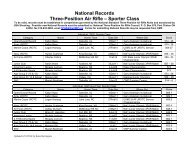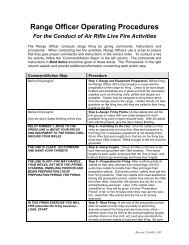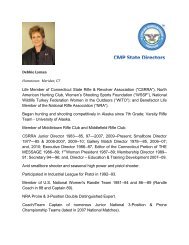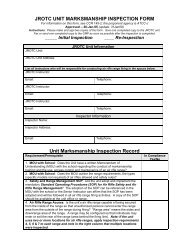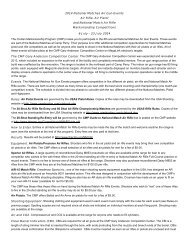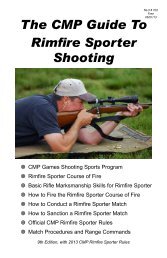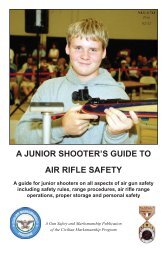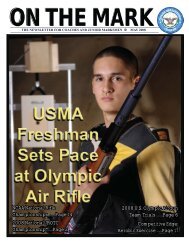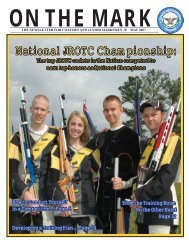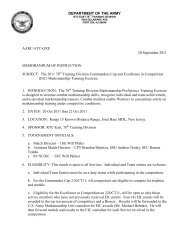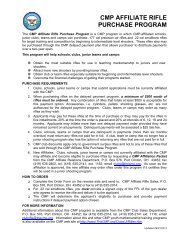summer 2010 - Civilian Marksmanship Program
summer 2010 - Civilian Marksmanship Program
summer 2010 - Civilian Marksmanship Program
You also want an ePaper? Increase the reach of your titles
YUMPU automatically turns print PDFs into web optimized ePapers that Google loves.
JUNE <strong>2010</strong> 19<br />
Georgia Teen Coping With Physical Challenge<br />
in Precision Air Rifle<br />
By Steve Cooper, CMP Writer/Editor<br />
CAMP PERRY, OHIO - Kelsey Moral<br />
looks like any other teenager, except<br />
maybe for the funky multi-colored canvas<br />
suit, ear plugs and flat boots. Okay, she<br />
looks like any other teenage precision air<br />
rifle shooter, and that’s just fine with her<br />
- in fact that’s exactly how she wants it.<br />
The red-haired 16-year-old junior at<br />
East Coweta High School in Sharpsburg,<br />
Georgia, also enjoys photography,<br />
working with her dogs, traveling from<br />
state to state to competitions and buzzing<br />
her grandparents’ lawn on their zero-turn<br />
mower.<br />
Unlike most teen shooters, Kelsey is<br />
dealing with a physical challenge that’s<br />
similar to that of an injured athlete who is<br />
rehabilitating from ACL surgery. But in<br />
her case the pain has always been there,<br />
and therapy has always been a way of life.<br />
“I was born with a mild case of spastic<br />
cerebral palsy,” Kelsey says. While the<br />
words cerebral palsy evoke images of<br />
wheelchair-bound youngsters, the reality<br />
is about 80 percent of the approximately<br />
800,000 CP sufferers in the US fall into<br />
Kelsey’s type, known as spastic diplegia,<br />
which primarily affects leg muscles.<br />
According to the National Institutes<br />
of Health, cerebral palsy doesn’t always<br />
cause profound disabilities. While one<br />
child with severe cerebral palsy might<br />
be unable to walk and need extensive<br />
lifelong care, another with mild CP might<br />
be only slightly affected and require no<br />
special assistance.<br />
Kelsey’s condition is characterized by<br />
having one or more tight muscle groups<br />
which can limit movement and it’s why<br />
she walks with a limp and sometimes has<br />
difficulty getting into and out of shooting<br />
positions.<br />
“Prior to joining the rifle team,<br />
she would never tell anyone what her<br />
disability was,” Kelsey’s mom Janice<br />
said. “Once she made the team, she soon<br />
felt comfortable with her disability. It’s<br />
small compared to what it could be, and<br />
now she tells people she has CP.”<br />
Kelsey’s coach, USMC MSGT Joel Skinner, Kelsey, and her mom, Janice, at the <strong>2010</strong><br />
USMC Service Championship.<br />
“Competitive shooting has given<br />
Kelsey an opportunity to take her mind<br />
off CP and the courage to talk about it,”<br />
her mom says.<br />
“When I asked her how she would<br />
like to explain her situation for this story,<br />
she said ‘I want to tell the truth, I have<br />
mild spastic CP - no big deal Mom!’”<br />
“By no means is CP going to get the<br />
best of me,” Kelsey said emphatically.<br />
“Thankfully, it only affects my legs,”<br />
Kelsey explained. “Because of my CP,<br />
I have had some hurdles to overcome.<br />
Some days my legs hurt so bad, I can<br />
hardly stand it – other days they’re okay.”<br />
Cerebral palsy isn’t a disease. It isn’t<br />
contagious and it can’t be passed from one<br />
generation to the next. There is no known<br />
cure for CP, but supportive treatments,<br />
medications and surgery can help many<br />
individuals improve their motor skills.<br />
Kelsey’s first appearance in a big<br />
match came in February at the Marine<br />
Corps JROTC Championship at Camp<br />
Perry. Though she finished in the middle<br />
of the pack, she scored second highest on<br />
her high school team in the postal qualifier<br />
leading up to the Service Championship,<br />
scoring 277 out of a possible 300 in Three-<br />
Position Air Rifle (3PAR).<br />
The MCJROTC Service<br />
Championship marked the first time<br />
Kelsey was able to get into the kneeling<br />
position for an important match. Though<br />
she cannot completely flex her legs,<br />
Kelsey was able to achieve a stable<br />
position and fire the match. Kelsey had<br />
only been practicing kneeling two months<br />
prior to the match.<br />
“Because of my muscle tone, I have<br />
not been able to kneel. So for about a year<br />
I shot standing twice. One day I decided<br />
that I really wanted to kneel like everyone<br />
else.”<br />
“Some days I can’t kneel at all; my<br />
legs just won’t let me. I’m in physical<br />
therapy and I work hard everyday<br />
with exercises to help me kneel more<br />
comfortably. Sometimes I worry that I’ll<br />
fall over because I feel unstable.”<br />
Continued on Page 20




